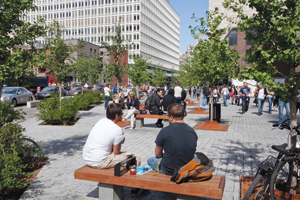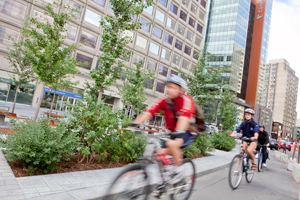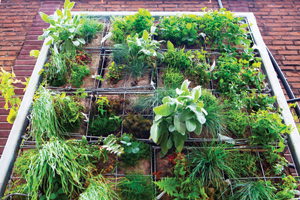Green scheme presented at city consultation

When the City of Montreal launched its development plan for the west end of the downtown core under the theme Quartier des grands jardins, Concordia University was identified as a key player in the area.
Certainly, with more than 50,000 students, employees and professors, not to mention visitors to its galleries, gyms, theatres, libraries, multiple conferences and special events, Concordia’s impact in the west end of the city, from downtown and across town to the western edge of Notre- Dame-de-Grâce, can’t be ignored. The university currently maintains some 50 buildings, representing 470,000 square metres of space.
Recently, a cross-sector team led by Acting Vice-President Services, Roger Côté, presented a brief to the Office de consultation publique de Montréal (OCPM).
Concordia elaborated the university’s long-term vision for the neighbourhood, which includes the Quarter Concordia urban planning project.
The university takes the theme Grands jardins very seriously, with an ongoing, demonstrated commitment to sustainability and ecological responsibility across its facilities. For instance, the John Molson School of Business (MB Building) was designed to earn Silver Certification through LEED (Leadership in Energy and Environmental Design). That building, and its sister across Guy Street, the Engineering, Computer Science and Visual Arts Integrated Complex (EV Building), both take advantage of the Guy-Concordia metro station, with tunnels connecting the buildings to the station in lieu of underground parking facilities. Among the recommendations made to the OCPM were changes to construction limits to increase density through the Quartier des grands jardins by encouraging new projects that take advantage of the access to public transit.
But Concordia’s commitment to ecological responsibility doesn’t begin and end with current building projects. The university has maintained its place as the most energy-efficient of all large Quebec universities for 13 years running, with each new construction or refurbishment employing motion sensors that trigger systems to turn off lights and reduce heating or cooling when there is no movement detected.
Among the university’s recommendations are those that would considerably increase green space opportunities throughout the Quartier des grands jardins. One project that Clarence Epstein, responsible for Special Projects and Cultural Affairs in the President’s Office, sees as completely possible in the very short term would be the construction of plantable medians separating the De Maisonneuve bicycle path from traffic between Bishop and Guy streets. Similar green medians exist in other parts of the city and the overall effect would enhance Place Norman-Bethune and reduce the stifling impact of heat islands in the warm summer months. “For over 10 years we’ve been working hand in hand with the city administration to revitalize this remarkable neighbourhood and there’s much more that we can do together,” said Epstein.

Those medians could be maintained by the hundreds of eager volunteers associated with the Concordia greenhouse located atop the Henry F. Hall Building. The project, maintained by students and staff at Sustainable Concordia, already oversees urban agriculture along Mackay and Bishop streets and a vertical garden on the mezzanine behind the Hall Building, all with the support of the university’s Facilities Management team.
“There are many students working to bring urban agriculture to Concordia’s campuses. Given the resources and space, we’ll landscape the ____ out of it,” promises Sustainability Coordinator Mariam Masud. The team, primarily student volunteers, is also hoping to get the OK to use a small strip of land behind the MB Building for a permaculture garden. This teaching garden would be used to demonstrate the benefits of companion plantings and favourable pests to reduce reliance on pesticides or chemicals.

Vert ta Ville (see related story), in partnership with the greenhouse, just launched a new season. The greenhouse team will also be growing tea for campus cafés and developing training and workshops in tandem with local schools and community groups. They have also renewed their commitment to create green spaces along Bishop and Mackay streets wherever possible. Eventually, Sustainable Concordia, working with the Dean of Students Office, would like to create a lounge with sustainably designed, impermanent fixtures on the terrace behind the Hall Building that could be enjoyed by students and locals. Martin Racine, of the Department of Design and Computation Arts, has expressed interest in assigning his students the task of developing the furnishings over the 2011-12 academic year.
All of these short-term projects could be supported by some of the more longterm proposals the university presented to the OCPM on April 20. Ideally, Concordia would like to expand downtown green space by extending the grounds of St. James the Apostle Church on Ste-Catherine Street right to Mackay Street. This would create a sizable garden at the foot of the eastern wall of the EV Building, and visually connect with the virtual garden of the stunning glass artwork on that facade created by Nicolas Baier. Epstein would like to see the city begin the process of placing a reserve on that land for the project in the next year.
Related links:
• Concordia in the Quartier des Grands Jardins
• Concordia’s Recommendations
• Sustainable Concordia
• Quartier des grands jardins at the Office de consultation publique de Montréal

